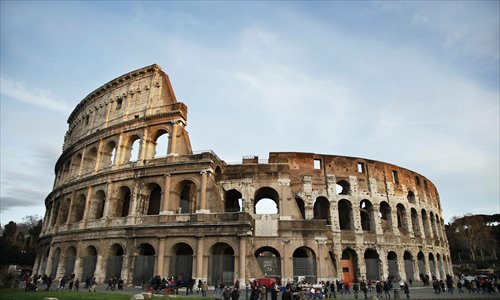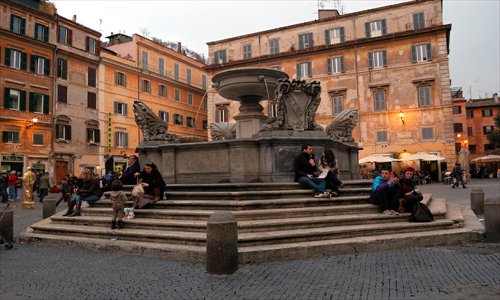City of eternity


No one is immune to the seduction of Rome, the hectic Italian capital that has been dazzling travelers, writers and artists since its inception almost 3,000 years ago. Unlike most other cities around the world, a visit to Rome doesn't necessarily require very detailed or carefully tailored travel plans - just get there, and world-famous monuments of ancient history will be found on every corner. Like an old aristocratic lady, Rome is the epitome of glamor, and wandering about its historic and architectural jewels feels like visiting a huge open-air museum.
Ancient introductions
Following the old saying "All roads lead to Rome," whether you arrive by plane, train or ferry, your first date will likely be with the city's heart, both geographic and historical. The Via dei Fori Imperiali, a cobbled boulevard that, extending from the large Piazza Venezia, is flanked by ruins from Rome's earliest majestic settlements. Finely inlaid marble columns and imposing walls alternate the view with ancient arches and squares that served as political arenas and centers for cultural life and commercial activity during the Roman Empire.
Though initiated by Julius Caesar, later emperors built their own fora in the vicinity, leaving a series of awe-inspiring ancient ruins sitting side by side with medieval churches, domes and modern palaces.
As if still under Julius Caesar's rule, today chariots pulled by horses run up and down the road and gladiators in costume stand in front of the Colosseum ready for photo ops - certainly a better deal than that shouldered by their predecessors two thousand years ago.
The Colosseum sits right at the end of the Via dei Fori Imperiali, and the aura left by its gory history has made it the city's international symbol. The monument begs to be gazed at for hours, to be the target of photo lenses and flights of historical fantasy. Its reputation precedes it, and the moment you find yourself standing before its bulky structure, you realize your expectations have been fully met.
Built around AD 70 by the emperors of the Flavian dynasty (AD 69-96), the Colosseum, or Amphitheatrum Flavium, stands out with its majesty, attracting travelers from all over the world every day. Likely the inspiration for the infamous Latin expression "panem et circenses," meaning bread and circuses - a reference to the simple, artificial gestures the government used to appease the masses - this amphitheater has witnessed some of the most cruel forms of entertainment recorded in history.
Initially devoted to propitiatory rituals, its shows quickly evolved into brutal games where gladiators, mostly slaves but also patricians in the quest for glory, fought each other or wild animals imported from northern Africa in order to appease the emperor and entertain the public. Before the installation of the underground cages and cells from which gladiators entered the arena, the Colosseum had also been used as a stage for theatrical naval battles, which saw its basin filled with water for the real boats that were brought in.
Standing with a majesty attainable only with time, the Colosseum has endured centuries of ruling families and withstood the ravages of two world wars. Arguably one of the best-preserved ancient ruins in the world, the Colosseum never fails to make tourists feel as if they were wandering through history.
Modern moment
During my stay in Rome, I couldn't possibly count how many times I went past the Colosseum, walked around its circumference and admired it from every angle, but I certainly remember that each time, I stared at it in awe, not only for its imposing structure, but for everything it represents, guarding the Eternal City through its past and present. In stark contrast to the anachronistic Ben Hur-like chariots and gladiators offering to pose for snapshots for tourists' cameras, today Rome's city center is a nonstop, high-energy fashion show as women come and go, rushing on their way to work or shopping in stilettos, defiant of the most insidious cobbled pavement, the typical road surface in the Italian capital.
Those interested in what life in the ancient city was like for its people will want to explore ancient Rome beyond the Colosseum. After taking in the Roman Forum, where religious events were held and local markets were set up during the Roman Empire, visitors can head for the Circus Maximus and move on to easily find the magnificent Baths of Caracalla, beautifully preserved thermal baths named for the infamous Roman emperor. Strolling around the ruins of a spa that in its heyday received 5,000 people a day provides an insight into ancient Romans' incredible hydraulic expertise, widely known megalomania and real knack for enjoying life. The latter is certainly something that has been inherited by today's Romans, as their love for la dolce vita has endured through centuries of rivalry and battles.
The ancients are not entirely to blame for this, since such pleasure-seeking is synonymous with the lifestyle of the gods, and as mythological tradition narrates, Romans are their descendents. According to legend, the city's founder, Romulus, twin of Remus and ancestor of the Gens Julia, was the son of the god Mars and the vestal virgin Rhea Silvia. Today at the Musei Capitolini, on Rome's Capitoline Hill, modern tourists can admire a statue of the two baby twins with the wolf that rescued them after they were abandoned.
Wherever you look in Rome, you are confronted by beauty and art, and this is how the city gets under your skin. Treasures are found everywhere, and after you've had your fill of ancient splendor, you don't need to go too far to plunge into more modern sights. Medieval, Renaissance and Baroque churches, fountains and obelisks look as if they were carved out of Chantilly cream. Even the most unsentimental of visitors are compelled to experience a bit of the Roman spirit by stopping for an espresso and walking through the settings of immortal movies like Federico Fellini's La Dolce Vita.
When in Rome…
Tourism must-do's include throwing a coin into the Trevi Fountain off Via del Corso and visiting the beautiful Piazza Navona to admire its fountains. This public space, built as a stadium by Emperor Domitian (AD 51-96), stands out of the crowd of monumental attractions, recalling its first-century splendor, when it attracted 30,000 spectators at a time. While there, watch a live street performance and pose for a portrait with one of the many painters lined up along the square. Not far from there lies the Pantheon, the former temple commissioned by Marcus Agrippa (63-12 BC) and consecrated to all the gods. Now a church, the Pantheon is considered one of the most extraordinary architectural efforts inherited from ancient Rome, with its diameter perfectly equivalent to its height and its oculus, an 8-meter opening in the center of the dome, thought to aid the connection with the heavens.
Before your mandatory stop in the Piazza di Spagna to enjoy a well-deserved break on the world-renowned steps of Trinità dei Monti, a line of patient and hopeful ice cream connoisseurs will likely lure you into Rome's most popular ice cream shop, Giolitti, which has produced delicious gelato since 1890.
A day in Rome invariably feels like traveling around the world as at practically every step you hear a different language. After spending a year in Shanghai - and developing an unhealthy fixation for all things Chinese - I never shy away from showing off the little I remember from my studies in mighty Zhongguo. One afternoon, I was stretched out on the Spanish Steps enjoying the sunshine when two Chinese tourists made my day by uttering a familiar phrase: Xiu xi? - Want to take a break? I couldn't help taking advantage of the situation and striking up a conversation. Our chat was made possible more by their English than my Putonghua, but throwing in some Chinese words here and there in the center of Rome made me realize how cosmopolitan the Italian capital is.
Whether you are a believer or not, a Christian or a Buddhist, Muslim or Hindu, a trip to Rome is not complete without a tribute to Saint Peter's Basilica, which boasts masterpieces like Michelangelo's spectacular La Pietà, as well as fountains, columns, crypts and minor chapels. The basilica lies in the heart of the Vatican's tiny city-state, the walled headquarters of Catholic spirituality and medieval papal kingdom. It is from this ground that popes have for centuries been weaving their networks of diplomatic relations, political alliances and commercial trade, while disposing of citizens' eternity according to holy scriptures and conveniently concocted encyclical letters.
Before Italian unification in 1870, the Vatican's rule sprawled up to Trastevere district, still now revered as one of Rome's quaintest and most traditional areas, embellished by cobblestone streets framed by medieval buildings. Adored by locals and tourists alike, as soon as night sets in, the Trastevere of today sparkles with the shimmering signs of pubs and restaurants spruced up for the evening.
After a day of passing through the centuries, it is only fair to end by enjoying the modern bella vita that is so key to Italy's character: tasting local delicacies and sipping an after-dinner drink while listening to one of the many live shows in Trastevere.
Rules of Thumb
Practical information: The local currency in Rome is the euro, and although traveling in Europe can be expensive at times, here it's not difficult to find affordable restaurants. As most monuments are outdoors, much sightseeing is free of charge. Prices of attractions such as the Colosseum, the Baths of Caracalla and the Sistine Chapel range from 7 to 15 euros (about $9 to $20).
What to say:While most tourist areas may have English-speaking staff in restaurants and monuments, it is recommended to carry a dictionary and a map in case you need to ask for information from local passersby who are not likely to speak a foreign language.
When to go:The best time for a visit to Rome is either April through June, or September through November, when temperatures are neither too hot nor frigid. If cold weather doesn't scare you, December is a nice time to visit the Italian capital to soak in the festive spirit and admire Christmas decorations and markets.
Where to stay: Accommodations in Rome range from luxurious five-star hotels to budget guest houses with prices starting from 30 euros for a double room per night. As public buses don't run regularly at night and metro stations close around 11 pm, it's advisable to look for accommodations within walking distance of the city center.
Transportation: The city's attractions are well connected to each other via public transport. A single ticket costs 1.5 euros and is valid for one ride of up to 100 minutes on the metro or bus. The city center is pleasant and very walkable, but if you plan to use public transport several times a day, you might want to consider a day pass, which costs 6 euros.
There are many ways to get to and from Rome's main airport, Fiumicino, the easiest being the fast train (for 14 euros) from Termini central train station that runs every thirty minutes and takes about half an hour of travel. Rates for taxis between the airport and the city center are fixed at around 45 euros.
For more information on Rome's public transit, go to atac.roma.it.